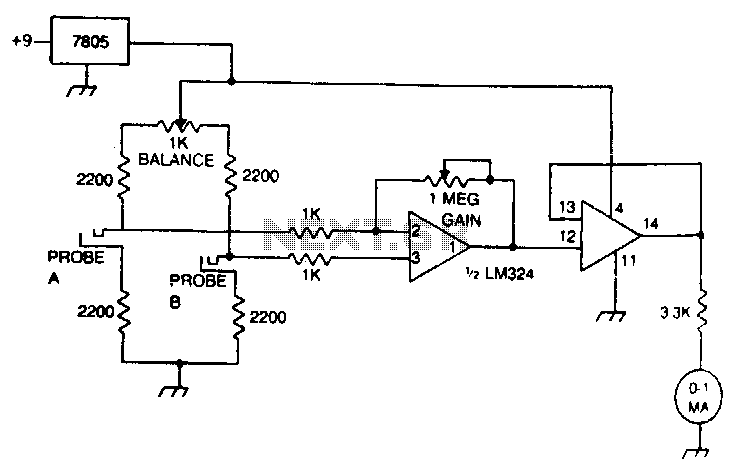
Temperature-reporting-digital-thermometer

The ROMs or PROMs must contain the correct code to convert data from the NE5037, which serves as the address for the ROMs or PROMs, into the appropriate segment driver codes. The displayed temperature can easily be converted to degrees Fahrenheit (°F) by the controller of a 0-63 ° temperature sensor or through the (P) ROMs. To display temperatures exceeding 99 °F, a third (hundreds) digit (P) ROM and display will be required. Additionally, an expensive clock can be constructed using NAND gates or inverters as illustrated.
The circuit employs ROMs or PROMs to facilitate the conversion of digital data received from the NE5037 interface into segment driver codes suitable for a display module. The NE5037 serves as a data source, providing input values that represent temperature readings from a sensor operating within a range of 0 to 63 degrees Celsius. The conversion to Fahrenheit is performed by the controller, which utilizes the programmed logic within the ROMs or PROMs to output the corresponding values in degrees Fahrenheit.
For temperature displays exceeding 99 °F, the design incorporates a third ROM dedicated to handling the hundreds digit. This additional ROM is essential for generating the correct segment codes to represent temperatures in the hundreds, ensuring that the display can accurately reflect higher temperature readings. The integration of this third ROM allows for seamless transitions between the tens and hundreds places in the displayed temperature, enhancing the functionality and usability of the system.
In conjunction with the temperature conversion functionality, the circuit also includes a clock mechanism that can be realized using NAND gates or inverters. This clock serves as a timing device within the overall system and can be designed to meet specific precision requirements. The use of basic logic gates such as NAND gates or inverters to construct a clock is a cost-effective approach, allowing for customizable frequency outputs that can be adjusted based on the application's needs.
Overall, the combination of ROMs or PROMs for temperature conversion and the implementation of a clock using NAND gates or inverters creates a versatile electronic circuit capable of accurately displaying temperature readings and providing timing functions.The ROMs or PROMs must have the correct code for converting the data from the NE5037 -used as address for the ROMs or PROMs-to the appropriate segment driver codes. The displayed amount could easily be converted to degrees Fahrenheit, °F, by the controller of (0-63 °temperature sensor) or through the (P) ROMs.
When doing this, a third (hundreds) digit(P)ROM and display will be needed for displaying temperatures above 99°F. An expensive~clock can be made from NAND gates or inverters as shown. 🔗 External reference
The circuit employs ROMs or PROMs to facilitate the conversion of digital data received from the NE5037 interface into segment driver codes suitable for a display module. The NE5037 serves as a data source, providing input values that represent temperature readings from a sensor operating within a range of 0 to 63 degrees Celsius. The conversion to Fahrenheit is performed by the controller, which utilizes the programmed logic within the ROMs or PROMs to output the corresponding values in degrees Fahrenheit.
For temperature displays exceeding 99 °F, the design incorporates a third ROM dedicated to handling the hundreds digit. This additional ROM is essential for generating the correct segment codes to represent temperatures in the hundreds, ensuring that the display can accurately reflect higher temperature readings. The integration of this third ROM allows for seamless transitions between the tens and hundreds places in the displayed temperature, enhancing the functionality and usability of the system.
In conjunction with the temperature conversion functionality, the circuit also includes a clock mechanism that can be realized using NAND gates or inverters. This clock serves as a timing device within the overall system and can be designed to meet specific precision requirements. The use of basic logic gates such as NAND gates or inverters to construct a clock is a cost-effective approach, allowing for customizable frequency outputs that can be adjusted based on the application's needs.
Overall, the combination of ROMs or PROMs for temperature conversion and the implementation of a clock using NAND gates or inverters creates a versatile electronic circuit capable of accurately displaying temperature readings and providing timing functions.The ROMs or PROMs must have the correct code for converting the data from the NE5037 -used as address for the ROMs or PROMs-to the appropriate segment driver codes. The displayed amount could easily be converted to degrees Fahrenheit, °F, by the controller of (0-63 °temperature sensor) or through the (P) ROMs.
When doing this, a third (hundreds) digit(P)ROM and display will be needed for displaying temperatures above 99°F. An expensive~clock can be made from NAND gates or inverters as shown. 🔗 External reference
Warning: include(partials/cookie-banner.php): Failed to open stream: Permission denied in /var/www/html/nextgr/view-circuit.php on line 713
Warning: include(): Failed opening 'partials/cookie-banner.php' for inclusion (include_path='.:/usr/share/php') in /var/www/html/nextgr/view-circuit.php on line 713